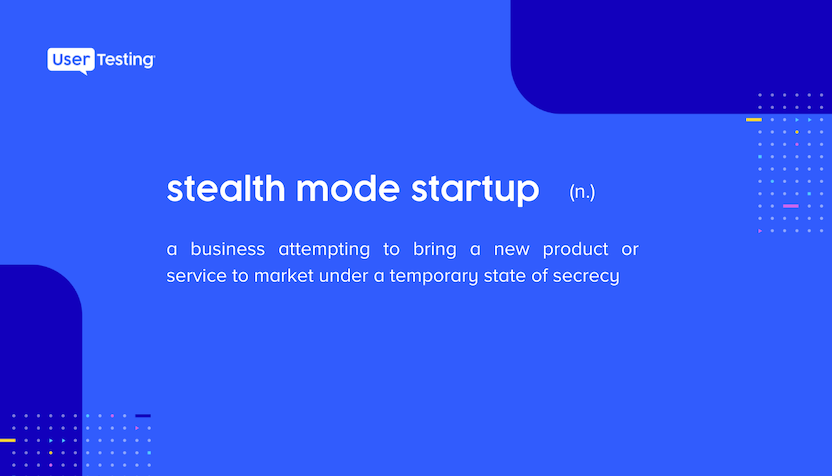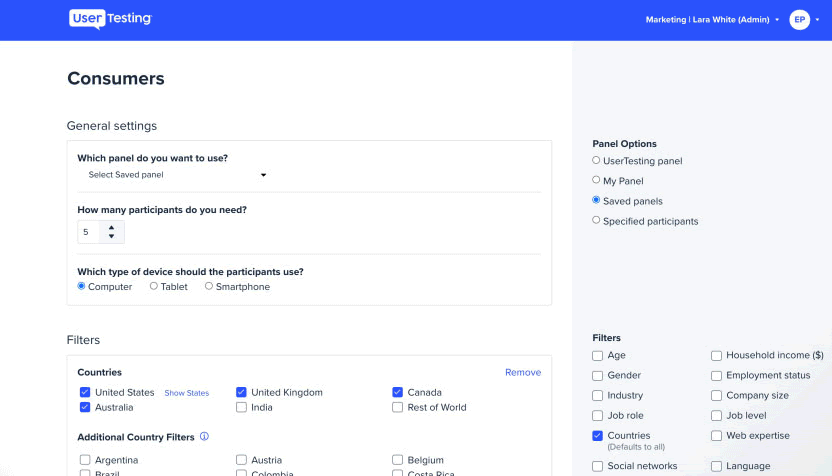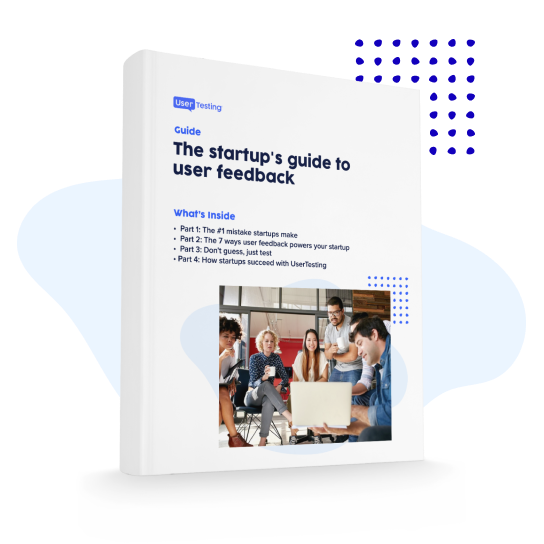
5 things stealth mode startups can test or validate and remain secret

Today, the landscape for starting a new business is extremely competitive. So competitive that the failure rate for most startups is quite high, landing around 90%. While this metric is quite staggering, there are ways to overcome the fate that many other starry-eyed entrepreneurs encounter. If you’re looking to start a new venture, you may want to consider beginning as a stealth mode startup. By doing so, you’ll gain a leg up on the competition, protect your ideas, and be able to focus on delivering a one-of-a-kind product or service to your customers.
Let’s start with the basics. And if the basics aren't for you, skip ahead to the section about testing.
What is a stealth mode startup?
A stealth mode startup is a business attempting to bring a new product or service to market under a temporary state of secrecy.

As the name implies, stealth mode startups aim to ideate, develop, and ultimately launch a new product or service without word getting out. Typically, this can happen in one of two ways—depending on the type of business you’re in.
The two types of stealth mode startups are:
- Total stealth mode
- And in-company stealth mode
Both types of stealth modes serve specific purposes, so it comes down to whether or not you’re starting a new business or launching a new product within an existing business. Let us explain.
What is a total stealth mode startup?
A total stealth mode startup is a new business whose primary focus is to keep all product-related actions and decisions as secret as possible from the public. This means, while you’re in stealth mode, your product or business will have no news coverage. No press releases. No website. No hype at all, from anywhere.
While that all may sound like a red flag, flying under the radar is a strategy that needs to be carefully considered and isn’t without benefits. For example, Firefly operated discreetly for two years before finally turning towards the public. Before we get to the benefits though, let us introduce the other type of stealth mode.
What is in-company stealth mode?
Unlike a stealth mode startup, in-company stealth mode is when an existing business intends to keep a new project, idea, or initiative secret from the public—sometimes even from investors and other stakeholders. It might sound somewhat deceptive, but it’s a common practice. Here’s why.
The primary purpose of in-company stealth mode is to avoid premature dismissal of new ideas. Oftentimes, companies will use code names for new ventures in order to cover up the true intention of the project.
Typically, this type of stealth mode is reserved for large companies—think Apple, Uber, or Tesla—who have the ability to free up extra resources within their company to work on the stealth mode project. And it might be obvious, but employees working on these projects are required to sign an NDA to protect the intellectual property and keep the secret under wraps.
So why go to all the trouble? The benefits.
What are the benefits of stealth mode startups?
To lay it all out there, the benefits of stealth mode startups include:
- Protection of intellectual property
- Anonymity
- Control over press coverage
- Headstart over the competition
- Set your own pace to market
1. Protection of intellectual property
If you’re considering a stealth mode startup, chances are you believe that your product will change the market or vertical. In this scenario, it’s imperative that no one discovers your idea before you’re able to introduce it to the world. This is especially true if a larger company with more resources than you agrees it’s an idea with merit.
Take your time to develop your product in secrecy and only bring it to market when you truly believe it’s ready.
2. Anonymity
Perhaps the most obvious outcome of being a stealth mode startup is that your business and product will enjoy the benefits of being anonymous. In other words, you and your team will be able to maintain explicit focus on your strategy and build the best product you can. Free from distractions and judgment, you can develop a go-to-market plan that will surely surprise the market when your anonymity is unveiled.
3. Control over press coverage
Somewhat hand-in-hand with being anonymous, stealth mode startups have total control over press coverage and pre-launch hype. This can be a major benefit that helps you focus on your product and get it ready for launch. While press coverage can be useful, it’s notorious for stirring up speculation and unwanted feedback on the direction of your product. Having control over press coverage means you get to deliver the message you want when you’re ready. In the long run, a clear focus on your mission—instead of building buzz or putting out fires—will help you meet your customer’s expectations.
4. Headstart over the competition
As soon as you reveal your product or your intentions to the world, there’s potential for competitors to come out of the woodwork. Thus begins the race to launching your product in the market first, acquiring customers, building hype, getting more coverage, the list goes on. And if your product isn’t truly the best it can be, you’re leaving the door open for bigger companies with more money to shut you out before you even stand a chance.
5. Set your own pace to market
Last but certainly not least, a stealth mode startup’s greatest competitive advantage is that they set their own pace to market. If you ignore the temptations for early momentum and focus on truly building a world-class product or service, you’ll put yourself in the best position to achieve success. As the age-old saying goes—haste makes waste.
The myth of stealth mode startups
While swearing to secrecy sounds tricky, there are mythical drawbacks that stealth mode startups face that simply aren’t true. For example, many people believe that finding product market fit or collecting feedback on your product is nearly impossible. How can you possibly begin to know your audience and understand your target market without at least revealing some of your product or ideas to the world? Moreover, how can you ask people what they like and dislike, need and don’t need, and so on without testing your product with real people?
Revealing elements of your product is, by its very nature, against the rules of a stealth mode startup, right? Short answer: no. And the truth is, there are ways to do all of these things whilst remaining in stealth mode.
Here are 5 methods for gathering stealth mode-approved feedback.
5 things stealth mode startups can test and get feedback on
When it comes to getting feedback on early concepts, assets, and other unreleased experiences the process doesn’t have to be overcomplicated. We recently launched a new feature within the UserTesting Human Insight Platform that allows you to safeguard confidential and sensitive information by requiring individuals to agree with terms that obligate them to protect any confidential information that they may view and access while completing tests you create.

With this new, streamlined experience for presenting custom confidentiality terms directly within the platform, you’re now able to present custom terms directly to test contributors before they even see the test or answer a single question.
This feature is especially helpful for stealth mode startups so you can get feedback on sensitive assets. Specifically, stealth mode startups can get feedback on:
- Early discovery ideas and concepts
- Product market fit
- User personas
- Prototypes
- Pricing
- And more
1. Getting feedback on early discovery ideas and concepts
Bringing a failing product to market is a feeling no entrepreneur ever wants to experience. However, when operating within a stealth mode startup, concept testing can be a difficult hurdle to overcome. Nevertheless, with confidentiality agreements in place, it’s a critical first step toward success.
Concept testing is crucial because it helps you predict the success or failure of a finished product early in the process. Whether you’re in the early stages of vetting new products, testing ideas, or comparing usefulness, consider testing your concept. By doing so, you’ll collect valuable customer insights and better predict whether or not you’re investing in something no one will use.
Hear how customer exposure hours are considered a significant success predictor when building products that are customer-centric.

2. Testing for product market fit
Product-market fit doesn’t happen by magic. However, all too often, startups make the mistake of imagining a brilliant idea for a product, investing huge amounts of time, money, and resources to design and develop it, then (maybe) getting some user feedback right before launching.
Just because you’ve designed a product that provides a solution doesn’t mean there was ever a problem to begin with. If you want to build a product with value, then you need to talk to your target customers—sooner rather than later. Sometimes during this process, you may even discover that there’s an entire group of people who were never on your radar before, but through feedback, you come to realize that there’s an entire audience that could benefit from your product or service. Ultimately, understanding your customers’ needs will not only help you design a product that meets their expectations, but it will also help you increase your speed to market.
3. Developing user personas
An emerging startup is always concerned with the needs of its users. And creating a user persona, however fictional, provides business teams the information they need to make real decisions considering the needs, experiences, and goals of their users. Stealth mode startups tend to have a difficult time accessing this information because they don’t want to reveal too much of their intent.
Nevertheless, connecting with potential users requires uncovering information about their attitudes, behaviors, characteristics, and desires using qualitative and quantitative information. To put it simply, to get a 360-degree view of your users, you’ll need to pull together quantitative information to understand scope and scale—as well as intent and preferences—and qualitative stories that breathe life and make the persona feel real.
Hear how a mix of quant and qual helps with building user personas.

4. Testing prototypes
Prototype testing consists of sharing prototypes or wireframes with real people to assess the viability of a design during the development cycle.
We suggest that you start testing as soon as you have a rough mockup of an idea and then continue to test as you revise your prototype. We find that getting user feedback early and often can help ensure that a site or app launch is successful.

5. Validate the pricing for your product
For stealth mode startups, arriving at a price that’s fair and matches up dollar spend for value can be difficult. However, it’s critical that when you launch, your price point is set in such a way that people want to buy your product.
There are several ways to do this, but we recommend that you take a cost-plus or competitor-based strategy. Both of which can be performed through the UserTesting platform.
Stealth mode startups shouldn’t be without feedback
Ultimately, choosing between a stealth mode startup and more traditional methods for bringing a product to market can really boil down to one question: am I doing something no one else is?
If your answer to that question is yes, then you might have unearthed a million-dollar idea that you don’t want to leak before you’re ready. However, building confidence that your product is the best it can be without gathering feedback is extremely difficult. So, for the occasional stealth mode startup founder who's still skeptical about testing ideas and prototypes because you’re concerned a contributor might steal it: don’t be.
The likely situation isn't that a contributor will steal your idea and build a business from it. The hard truth is that it’s more likely you go to market with an inferior product that doesn’t meet real needs and give someone else the opportunity to build a better product by understanding the flaws that caused yours to miss the mark.
In the end, it’s ok if you spend months (or longer) working on a product behind the curtains, but make sure you’re getting feedback along the way. There’s no excuse anymore to enter the market eyes wide shut. It may take a lot of personal restraint to keep your product under wraps, but in the long run, you may reap benefits you could have never anticipated.
In this Article

The startup's guide to user feedback
The startup's guide to user feedback





